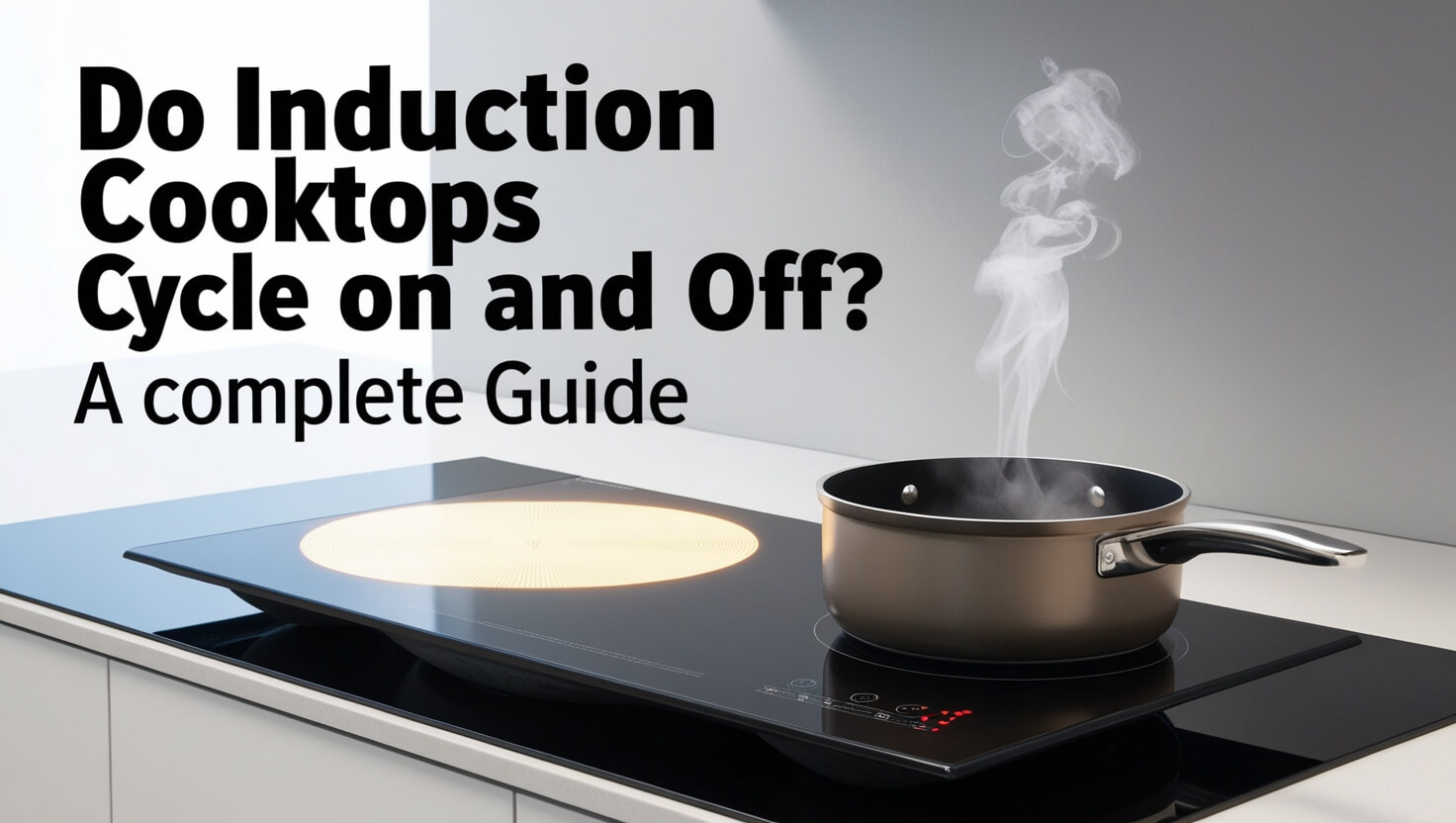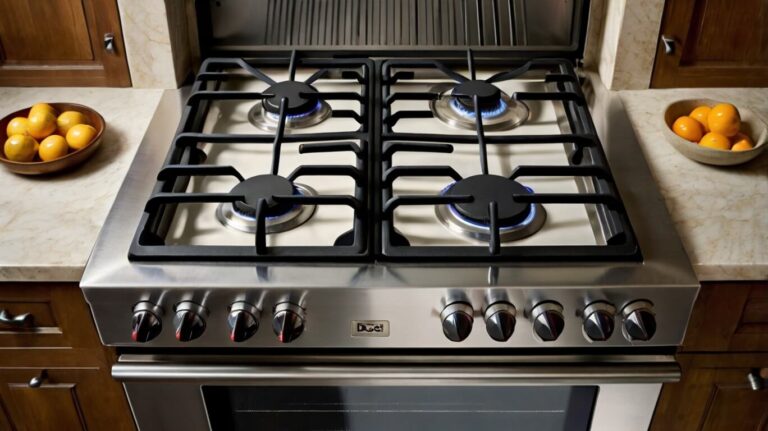
Induction cooktops do cycle on and off, but the way they do it is unique to this cooking technology. This cycling helps maintain precise temperatures and protect the cooktop’s components. How often and when this happens depends on several factors, including the cooktop’s quality and the power setting you’re using.
Induction cooking has gained popularity for its efficiency and precision. But many home cooks wonder about this cycling behavior. Is it normal? Does it affect cooking performance? We’ll answer these questions and more in this comprehensive guide.
What Is an Induction Cooktop?
Before we dive into cycling, let’s cover the basics. An induction cooktop uses electromagnetic fields to heat your pots and pans directly. This method is different from traditional gas or electric stoves.
How Induction Cooking Works
Induction cooktops have a coil of metal under the cooking surface. When you turn it on, an electric current flows through this coil. This creates a magnetic field. When you place a compatible pot or pan on the cooktop, this field creates electric currents in the cookware. These currents then heat up your pot or pan.
Advantages of Induction Cooking
Induction cooking offers several benefits:
- Speed: It heats up faster than gas or electric stoves.
- Energy efficiency: It wastes less energy because it heats the pot directly.
- Safety: The cooktop itself doesn’t get as hot as other types.
- Precise control: You can adjust temperatures more accurately.
The Cycling Phenomenon in Induction Cooktops
Now, let’s tackle the main question: Why do induction cooktops cycle on and off?
Why Do Induction Cooktops Cycle?
Induction cooktops cycle for two main reasons:
- Temperature control: Cycling helps maintain a steady temperature, especially at lower settings.
- Component protection: It prevents overheating of the cooktop’s internal parts.
When Does Cycling Occur?
Cycling can happen at various power levels, but it’s most noticeable at low to medium settings. At high power, many quality cooktops can maintain a constant output without cycling.
Factors Affecting Induction Cooktop Cycling
Several things influence how an induction cooktop cycles:
- Cooktop quality
- Power setting
- Cookware type and size
- Amount of food being cooked
Cycling at Different Power Levels
Let’s break down how cycling works at various power settings.
Low Power Settings and Cycling
At low power, most induction cooktops cycle on and off to maintain a low, steady heat. This cycling can be more noticeable because the “on” periods are shorter and less frequent.
Medium Power Settings and Cycling
Medium settings often involve cycling too, but the “on” periods are typically longer than at low settings. This results in more consistent heat.
High Power Settings and Cycling
High-quality induction cooktops often don’t need to cycle at high power settings. They can maintain a constant output. However, some may still cycle to protect their components from overheating.
Types of Induction Cooktop Cycling
Not all cycling is the same. There are different ways induction cooktops manage their power output.
Pulsing vs. On/Off Cycling
Some cooktops use a pulsing method, rapidly switching between full power and off. Others use a more gradual on/off cycle. The pulsing method can offer more precise control but might cause more noticeable effects on cooking.
Continuous Power Output
High-end induction cooktops can often provide continuous power output at lower settings. This means less cycling and more consistent heat.
Impact of Cycling on Cooking Performance
How does cycling affect your cooking? Let’s find out.
Temperature Control and Cycling
Cycling helps maintain precise temperatures. For example, to keep a steady simmer, the cooktop might cycle on and off to average out to the right temperature.
Effects on Different Cooking Techniques
Cycling can affect various cooking methods:
- Simmering: Might require adjusting your technique to account for the cycling.
- Searing: Usually not affected much, as it’s done at high heat where cycling is less common.
- Sauce-making: May need more attention to prevent scorching during “on” cycles.
Comparing Induction Cycling to Other Cooktop Types
How does induction cycling compare to other cooking methods?
Induction vs. Electric Cooktop Cycling
Electric cooktops also cycle, but differently. They use heating elements that glow red when hot. These elements cycle on and off to maintain temperature. Induction cycling is generally faster and more precise.
Induction vs. Gas Cooktop Heat Control
Gas stoves don’t cycle in the same way. They maintain heat by adjusting the flame size. This can be less precise than induction but offers continuous heat without cycling.
Quality Indicators in Induction Cooktops
When shopping for an induction cooktop, consider these factors related to cycling.
Minimum Continuous Power Output
Better cooktops can maintain lower continuous power outputs without cycling. This allows for more precise low-temperature cooking.
Cycle Length and Frequency
Higher quality cooktops often have shorter, more frequent cycles. This results in more consistent heating and better cooking control.
Common Issues Related to Induction Cooktop Cycling
Cycling can sometimes lead to a few quirks. Here’s what to watch out for.
Clicking Sounds During Cycling
You might hear clicking noises when your cooktop cycles. This is usually normal and caused by the power switching on and off.
Uneven Heating Due to Cycling
In some cases, cycling can cause slight temperature fluctuations. This is more noticeable with thinner cookware or at very low settings.
Troubleshooting Cycling Problems
How can you tell if cycling is normal or a sign of trouble?
When Cycling Is Normal
Cycling is typically normal:
- At low to medium power settings
- When you hear occasional clicking
- If heating remains relatively consistent
When Cycling Indicates a Problem
Be concerned if:
- Cycling occurs at high power settings
- There’s excessive clicking or other noises
- Heating is very inconsistent or stops completely
Choosing the Right Induction Cooktop
Want to minimize cycling issues? Here’s what to look for when buying an induction cooktop.
Factors to Consider for Optimal Performance
- Power range: Look for cooktops with a wide power range.
- Number of power levels: More levels allow for finer control.
- Brand reputation: Established brands often have better technology.
Reading Product Specifications
Pay attention to:
- Minimum power output
- Maximum power output
- Number of power levels
- Any mentions of “continuous power” technology
Tips for Cooking with Cycling Induction Cooktops
Here are some ways to work with, not against, the cycling nature of induction cooktops.
Adjusting Cooking Techniques
- Stir more often when cooking at low temperatures.
- Use the residual heat in your cookware to your advantage.
- Experiment with different power levels to find the sweet spot for various dishes.
Selecting Appropriate Cookware
- Use cookware with thick, heavy bases for more even heat distribution.
- Make sure your pots and pans are induction-compatible.
- Match the size of your cookware to the size of the cooking zone for best results.
Future of Induction Cooking Technology
What’s next for induction cooking? Let’s take a peek into the future.
Advancements in Power Control
Newer technologies are allowing for more precise power control. This could lead to less noticeable cycling and even better cooking performance.
Innovations to Reduce Cycling
Some manufacturers are working on ways to provide truly continuous power at all settings. This could eliminate cycling altogether in future models.
Conclusion
Induction cooktop cycling is a normal part of how these appliances work. It helps maintain precise temperatures and protects the cooktop’s components. While it can take some getting used to, the benefits of induction cooking – speed, efficiency, and precise control – often outweigh any inconvenience from cycling.
Understanding how and why induction cooktops cycle can help you make the most of this cooking technology. Whether you’re considering buying an induction cooktop or already own one, knowing about cycling can improve your cooking experience.
Remember, cycling doesn’t mean your cooktop is faulty. It’s just part of the induction cooking process. With the right techniques and cookware, you can work with the cycling to achieve great cooking results. As technology advances, we may see even better performance and less noticeable cycling in future induction cooktops.






